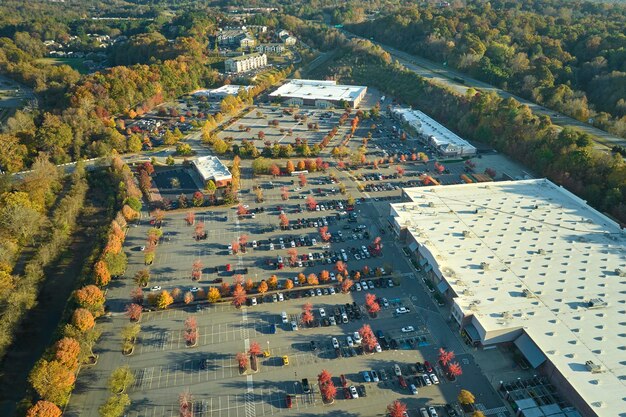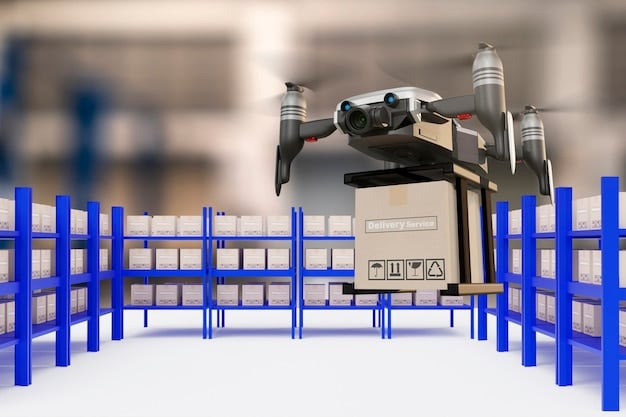The Latest Warehouse Automation Advancements for US Distribution Centers

The latest advancements in warehouse automation for US distribution centers include robotics, AI-driven inventory management, and advanced data analytics, significantly enhancing efficiency and reducing operational costs.
In today’s fast-paced market, optimizing your distribution center is crucial, and the latest advancements in warehouse automation for US distribution centers are revolutionizing how businesses operate by increasing efficiency and delivering significant cost savings.
Understanding Warehouse Automation
Warehouse automation involves using technology to minimize manual labor, increase productivity, and reduce errors by automating tasks traditionally performed by humans. This includes everything from inventory management to order fulfillment.
Benefits of Automation
Automating key processes within a warehouse environment leads to several advantages that positively impact operational efficiency and financial performance. These benefits make automation a compelling investment for distribution centers aiming to stay competitive in today’s fast-paced market.
- Increased Accuracy: Automated systems minimize human error in picking, packing, and shipping processes.
- Reduced Labor Costs: By automating repetitive tasks, businesses can reduce their reliance on manual labor, leading to significant savings.
- Improved Efficiency: Automated systems can perform tasks faster and more consistently than humans, leading to higher throughput.
Ultimately, understanding the key drivers and components of warehouse automation and its numerous benefits is crucial for distribution centers looking to remain competitive and efficient.

Robotics in Modern Warehouses
Robotics play a pivotal role in modern warehouse automation, greatly enhancing efficiency, accuracy, and speed. These robots are designed to take on a variety of tasks, freeing up human employees for more strategic and complex responsibilities.
Types of Robots Used
Different types of robots are deployed based on the specific needs and layout of the warehouse. Each type offers unique capabilities that contribute to overall automation efficiency.
- Automated Guided Vehicles (AGVs): These robots follow predefined paths to transport materials between locations.
- Autonomous Mobile Robots (AMRs): AMRs use advanced sensors and navigation to move around the warehouse without fixed paths.
- Picking Robots: These robots are designed to retrieve items from shelves and prepare them for shipping.
Implementing robotics effectively requires a strategic approach, beginning with a careful evaluation of the distribution center’s needs. By strategically integrating robotics, distribution centers can transform their operations, achieving higher levels of efficiency, accuracy, and overall performance.
AI-Driven Inventory Management
Artificial intelligence (AI) is revolutionizing inventory management, offering smarter, more responsive solutions that significantly improve operational efficiency. AI-driven systems analyze vast amounts of data to optimize inventory levels and predict demand with remarkable accuracy.
Predictive Analytics
Predictive analytics leverage historical data to forecast future demand, allowing businesses to optimize their inventory levels, reduce stockouts, and minimize excess inventory. This helps keep the operation going smoothly.
Predictive analytics uses algorithms to identify patterns and trends in sales data, seasonal fluctuations, and economic indicators. By analyzing this data, businesses can anticipate changes in demand and adjust inventory levels accordingly.

Advanced Data Analytics
Advanced data analytics is essential for optimizing warehouse operations, providing actionable insights that drive efficiency and reduce costs. By harnessing the power of data, distribution centers can make smarter decisions and continuously improve their processes.
Real-Time Monitoring
Real-time monitoring involves tracking key performance indicators (KPIs) to identify bottlenecks, improve workflow, and enhance overall productivity. It enables instant response to issues, ensuring smooth operations.
Real-time dashboards provide visibility into critical metrics such as order processing times, inventory levels, and equipment performance. This helps identify areas where immediate action is needed.
Implementing Automation Successfully
Successfully implementing automation in a US distribution center requires careful planning, strategic investment, and a phased approach. Factors such as warehouse layout and available resources can hinder the implementation.
Choosing the Right Solutions
Selecting the appropriate automation solutions is critical for maximizing the benefits of automation. Businesses must evaluate their specific needs, budget, and long-term goals.
Consider factors such as the size of the warehouse, the types of products handled, and the volume of orders processed. Assess how different automation technologies can address specific challenges and improve operational efficiency.
Overcoming Challenges in Automation
Despite the numerous benefits of warehouse automation, distribution centers often face challenges during implementation. Addressing these issues proactively is crucial for successful integration.
Initial Investment Costs
The initial investment for automation systems can be substantial, posing a barrier for some businesses. However, long-term cost savings and improved efficiency often outweigh the upfront expenses.
Explore financing options, such as leasing or subscription-based models, to mitigate the initial financial burden. Additionally, prioritize automation projects that offer the highest return on investment based on the center’s needs.
Future Trends in Warehouse Automation
As technology continues to advance, several emerging trends promise to further revolutionize warehouse automation, improving efficiency, and reducing costs. Staying informed about these developments is essential for distribution centers to remain competitive.
Continued AI Integration
AI will become even more deeply integrated into warehouse operations, optimizing decision-making and enhancing overall efficiency. This includes AI-powered robots, predictive analytics, and advanced planning systems.
AI-powered robots will become more sophisticated, able to handle complex tasks such as picking, packing, and sorting, with greater accuracy and speed. Predictive analytics will provide even more accurate forecasts, enabling better inventory management and resource allocation.
| Key Point | Brief Description |
|---|---|
| 🤖 Robotics | Automated Guided Vehicles (AGVs) and Autonomous Mobile Robots (AMRs) enhance material transport. |
| 📊 Data Analytics | Real-time monitoring enhances the identification of bottlenecks, workflow, and overall productivity. |
| 🧠 AI | Predictive analysis using inventory data to forecast future demand, and reduce stockouts. |
| 💰 Investment | Explore financing options, such as leasing or subscription-based models, to mitigate the initial financial burden. |
Frequently Asked Questions
▼
Warehouse automation improves efficiency, reduces labor costs, increases accuracy, and enhances throughput by automating repetitive tasks. Optimizing inventory management reduces excess stock.
▼
Robots can perform tasks faster and more consistently than humans, enhancing overall productivity. Autonomous Mobile Robots (AMRs) navigate dynamically. Robots assist the operator in performing the operation faster.
▼
AI optimizes inventory levels and predicts demand with high accuracy. AI provides insights that help reduce instances when items are out of stock.
▼
The initial investment costs can be high, and there can be a resistance to change from employees, which impacts the effective management of warehouse operations overall.
▼
Keep following AI implementation, advanced robotics, and IoT applications trends to enhance optimization in warehouses. IoT also helps track and maintain operations performance.
Conclusion
The latest advancements in warehouse automation for US distribution centers offer transformative opportunities to increase efficiency, reduce costs, and stay competitive in today’s fast-paced market. Businesses can enhance their operations by embracing robotics, AI-driven management, and data analytics. These technologies provide improvements in productivity and accuracy.





